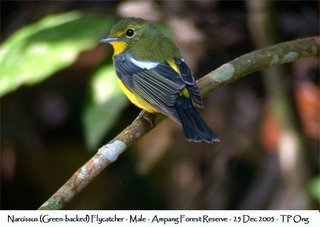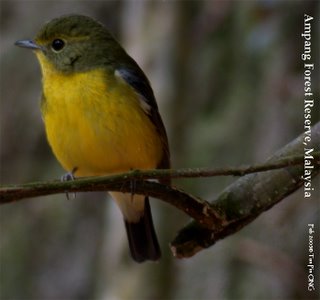Friday, January 13, 2006
Narcissus (Green-backed) Flycatcher - Ficedula narcissina elisae
I seem to have repeated luck with this small flycatcher. Having seen them in 2 consequitive wintering seasons. A male was first photgraphed on 09 Feb 2005 and then after more than 10 months later on Xmas day, 25 Dec 2005. Both birds(or possibly the same individual ?!) were photographed at the same spot and about the same time of the day ~ 10am. What a coincidence!
Common Name: Narcissus Flycatcher(elisae race) or Green-backed Flycatcher
Scientific Name: Ficedula narcissina elisae, Ficedula elisae
Note: Some taxonomists have regarded it as a distinct species and hence it is called Green-backed Flycatcher
Sighting Location: Taman Rimba Ampang (Ampang Forest Reserve), Selangor, Malaysia. About 1 hour drive from KL Twin Towers.
Habitat: Secondary foothill rain forest with streams running through. The flycatcher had been seen wandering out in more open tree in the park.
 A very tame bird when hunting for insects/larva along the paved padestrian road.
A very tame bird when hunting for insects/larva along the paved padestrian road.

Earlier in Feb 2005, a male was photographed at the same spot. First spotted by my birding buddy Yong DingLi, a Singaporean birder. This is probably a subadult or first winter male, because the white wing bar is very narrow and barely visible.
 Same "subadult" male photographed on 09 Feb 2005
Same "subadult" male photographed on 09 Feb 2005
The faint light olive brow and greenish head and mantle is distinct for this species.

Males of both Green-backed Flycatcher and another closely related Yellow-rumped Flycatcher (Ficedula zanthopygia) have yellow rump, but Green-backed lacks the distinctive broad white brow.
Below are photos of a female photographed on 09 Feb 2005 at another spot 100 meters away from where the male was taken. Female is different from male by having greyer upperpart, duller yellow on the breast and olive-green(not yellow) rump.
 Female
Female

Green-backed Flycatcher used to be very uncommon (or rather overlooked?) in its wintering ground in Malaysia. There have been more reports in recent years, probaly due to more observers. Hope these photos will help viewers to better understand on its identification features.
In near future, I hope to add some links and research studies on this little known flycatcher.
Please send your comments to copsychus at yahoo dot com.
Happy Birdwatching!!
TP Ong
Common Name: Narcissus Flycatcher(elisae race) or Green-backed Flycatcher
Scientific Name: Ficedula narcissina elisae, Ficedula elisae
Note: Some taxonomists have regarded it as a distinct species and hence it is called Green-backed Flycatcher
Sighting Location: Taman Rimba Ampang (Ampang Forest Reserve), Selangor, Malaysia. About 1 hour drive from KL Twin Towers.
Habitat: Secondary foothill rain forest with streams running through. The flycatcher had been seen wandering out in more open tree in the park.
 A very tame bird when hunting for insects/larva along the paved padestrian road.
A very tame bird when hunting for insects/larva along the paved padestrian road.
Earlier in Feb 2005, a male was photographed at the same spot. First spotted by my birding buddy Yong DingLi, a Singaporean birder. This is probably a subadult or first winter male, because the white wing bar is very narrow and barely visible.
 Same "subadult" male photographed on 09 Feb 2005
Same "subadult" male photographed on 09 Feb 2005The faint light olive brow and greenish head and mantle is distinct for this species.

Males of both Green-backed Flycatcher and another closely related Yellow-rumped Flycatcher (Ficedula zanthopygia) have yellow rump, but Green-backed lacks the distinctive broad white brow.
Below are photos of a female photographed on 09 Feb 2005 at another spot 100 meters away from where the male was taken. Female is different from male by having greyer upperpart, duller yellow on the breast and olive-green(not yellow) rump.
 Female
Female
Green-backed Flycatcher used to be very uncommon (or rather overlooked?) in its wintering ground in Malaysia. There have been more reports in recent years, probaly due to more observers. Hope these photos will help viewers to better understand on its identification features.
In near future, I hope to add some links and research studies on this little known flycatcher.
Please send your comments to copsychus at yahoo dot com.
Happy Birdwatching!!
TP Ong
